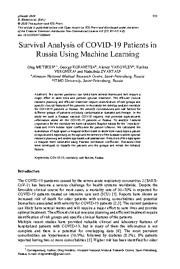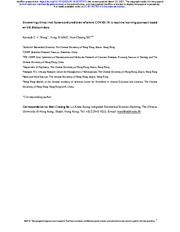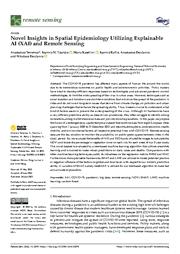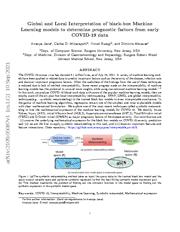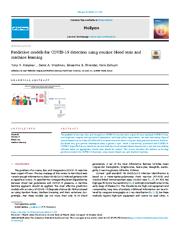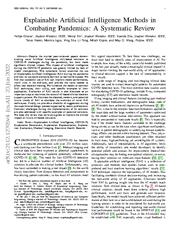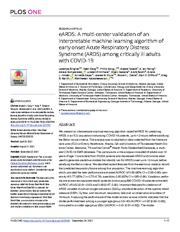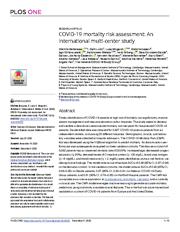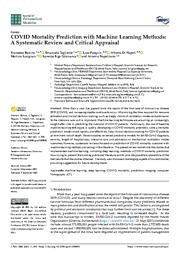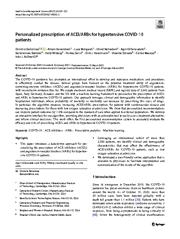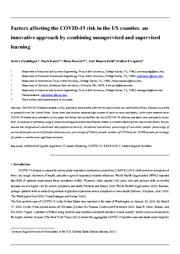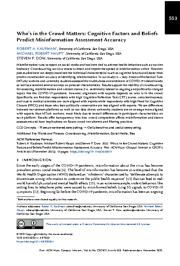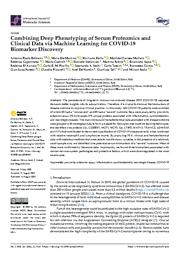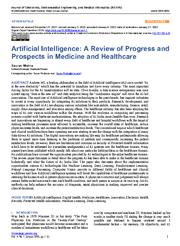A copy of this work was available on the public web and has been preserved in the Wayback Machine. The capture dates from 2022; you can also visit the original URL.
The file type is application/pdf.
Filters
Survival Analysis of COVID-19 Patients in Russia Using Machine Learning
2020
Studies in Health Technology and Informatics
In this study we develop analyze mortality for COVID19 patients in Russia. We identify comorbidities and risk factors for different groups of patients including cardiovascular diseases and therapy. ...
To analyze Features importance for the mortality we have calculated Shapley values for the "mortality" class and ANN hidden layer coefficients for patient lifetime. ...
The work of Georgy Kopanitsa was financially supported by the Government of the Russian Federation through the ITMO fellowship and professorship program. ...
doi:10.3233/shti200644
pmid:33087616
fatcat:gnfpe4qqyfdqjmjj2wrbzpldum
Uncovering clinical risk factors and prediction of severe COVID-19: A machine learning approach based on UK Biobank data
[article]
2020
medRxiv
pre-print
Shapley dependency and interaction plots were used to evaluate the pattern of relationship between risk factors and outcomes. Results: A total of 2386 severe and 477 fatal cases were identified. ...
Methods: Based on the UK Biobank(UKBB data), we built machine learning(ML) models to predict the risk of developing severe or fatal infections, and to evaluate major risk factors involved. ...
Acknowledgements This work was supported partially by the Lo Kwee Seong Biomedical Research Fund from The Chinese University of Hong Kong. We thank Prof. ...
doi:10.1101/2020.09.18.20197319
fatcat:oq7tk3a7kvhmdgme3offgbkske
Novel Insights in Spatial Epidemiology Utilizing Explainable AI (XAI) and Remote Sensing
2022
Remote Sensing
This novel dataset is evaluated by a tree-based machine learning algorithm that utilizes ensemble learning and is trained to make robust predictions on daily cases and deaths. ...
In this paper, we propose the fusion of a heterogeneous, spatio-temporal dataset that combine data from eight European cities spanning from 1 January 2020 to 31 December 2021 and describe atmospheric, ...
Conflicts of Interest: The authors declare no conflict of interest. ...
doi:10.3390/rs14133074
fatcat:leoysstvubaddmyple3twa2fuq
Global and Local Interpretation of black-box Machine Learning models to determine prognostic factors from early COVID-19 data
[article]
2021
arXiv
pre-print
A variety of machine learning models have been applied to related data to predict important factors such as the severity of the disease, infection rate and discover important prognostic factors. ...
Often the usefulness of the findings from the use of these techniques is reduced due to lack of method interpretability. ...
They identify a total of 10 features from their 52 feature dataset. Gemmer et.al 18 propose an alternative fuzzy classifier based approach for the task of mortality prediction. ...
arXiv:2109.05087v1
fatcat:u4fm5744xzar3har7oyb6vjvmi
Machine Learning Based Prediction of COVID-19 Mortality Suggests Repositioning of Anticancer Drug for Treating Severe Cases
[article]
2021
medRxiv
pre-print
In this work, we developed a machine learning model which predicts mortality for COVID-19 patients using data from the multi-center Lean European Open Survey on SARS-CoV-2-infected patients (LEOSS) observational ...
Altogether, our work demonstrates that interpretation of machine learning based risk models can point towards drug targets and new treatment options, which are strongly needed for COVID-19. ...
The LEOSS study group contributed at least 5 per mille to the analyses of this study: University Hospital Regensburg (Frank Hanses), Technical University of Munich (Christoph Spinner), University Hospital ...
doi:10.1101/2021.11.11.21266048
fatcat:exor633miray7otqopp5bfqria
Predictive models for COVID-19 detection using routine blood tests and machine learning
2022
Heliyon
This review describes the abilities to develop predictive models for COVID-19 detection using routine blood tests and machine learning. ...
Data of routine blood tests as a base of SARS-CoV-2 invasion detection allows using the most practical medicine facilities. ...
A game theory-based Shapley value method can provide a reliable, feature extraction [83, 84] An ensemble learning based on combining several classification algorithms and generating a final prediction ...
doi:10.1016/j.heliyon.2022.e11185
fatcat:4qjrlm5gjjbvzis5fzyatahrai
Explainable Artificial Intelligence Methods in Combating Pandemics: A Systematic Review
[article]
2022
arXiv
pre-print
We find that successful use of XAI can improve model performance, instill trust in the end-user, and provide the value needed to affect user decision-making. ...
We hope this review may serve as a guide to improve the clinical impact of future AI-based solutions. ...
Benoit Marteau from Bio-MIBLab for his help on reviewing the manuscript. This research was supported by a Wallace H. Coulter Distinguished Faculty Fellowship (M. D. ...
arXiv:2112.12705v4
fatcat:g44642qdnfchnmhgzsaqwjacua
eARDS: A multi-center validation of an interpretable machine learning algorithm of early onset Acute Respiratory Distress Syndrome (ARDS) among critically ill adults with COVID-19
2021
PLoS ONE
Clinical data from 35,804 patients who developed ARDS and controls were used to generate predictive models that identify risk for ARDS onset up to 12-hours before satisfying the Berlin criteria. ...
The machine learning algorithm which provided the best performance exhibited AUROC of 0.89 (95% CI = 0.88–0.90), sensitivity of 0.77 (95% CI = 0.75–0.78), specificity 0.85 (95% CI = 085–0.86). ...
Acknowledgments Cerner Real-World Data is extracted from the EMR of hospitals (de-identified) in which Cerner has a data use agreement. ...
doi:10.1371/journal.pone.0257056
pmid:34559819
fatcat:m76h7iqbenelrphr6fhim6xu5a
COVID-19 mortality risk assessment: An international multi-center study
2020
PLoS ONE
The CMR model leverages machine learning to generate accurate mortality predictions using commonly available clinical features. ...
This is the first risk score trained and validated on a cohort of COVID-19 patients from Europe and the United States. ...
We would like to thank A ´lvaro Fernandez Galiana for helping us to get access to the data sources from Spain and reviewing the manuscript. We would also like to thank Aggelos Stefos, Sarah P. ...
doi:10.1371/journal.pone.0243262
pmid:33296405
pmcid:PMC7725386
fatcat:s54swwnprvcsdfi6hrntfaqjqq
COVID Mortality Prediction with Machine Learning Methods: A Systematic Review and Critical Appraisal
2021
Journal of Personalized Medicine
Particularly, the use of baseline machine learning techniques is rapidly developing in COVID mortality prediction, since a mortality prediction model could rapidly and effectively help clinical decision-making ...
More than a year has passed since the report of the first case of coronavirus disease 2019 (COVID), and increasing deaths continue to occur. ...
Conflicts of Interest: The authors declare no conflict of interest. ...
doi:10.3390/jpm11090893
pmid:34575670
pmcid:PMC8467935
fatcat:jtff7snhczbvxnctsyoocmbkvq
Personalized prescription of ACEI/ARBs for hypertensive COVID-19 patients
2021
Health Care Management Science
We couple electronic medical record (EMR) and registry data of 3,643 patients from Spain, Italy, Germany, Ecuador, and the US with a machine learning framework to personalize the prescription of ACEIs ...
Our approach leverages clinical and demographic information to identify hospitalized individuals whose probability of mortality or morbidity can decrease by prescribing this class of drugs. ...
Using machine learning, we are able to identify patients who would benefit the most by receiving this type of medication. ...
doi:10.1007/s10729-021-09545-5
pmid:33721153
pmcid:PMC7958102
fatcat:ettnp6raxnhwhfq6fu6323jsla
Factors affecting the COVID-19 risk in the US counties: an innovative approach by combining unsupervised and supervised learning
[article]
2021
arXiv
pre-print
Some states and counties reported high number of positive cases and deaths, while some reported lower COVID-19 related cases and mortality. ...
In this paper, the factors that could affect the risk of COVID-19 infection and mortality were analyzed in county level. ...
“Risk Factors of Critical & Mortal COVID-19 Cases: A Systematic Literature Review and Meta-
Analysis.” Journal of Infection 81(2): e16–25. ...
arXiv:2106.12766v2
fatcat:rzv2e7bfercdvacigtk3dh6r2y
Who's in the Crowd Matters: Cognitive Factors and Beliefs Predict Misinformation Assessment Accuracy
2022
Proceedings of the ACM on Human-Computer Interaction
Crowdsourcing can be a means to detect and impede the spread of misinformation online. ...
However, past studies have not deeply examined the individual characteristics - such as cognitive factors and biases - that predict crowdworker accuracy at identifying misinformation. ...
ACKNOWLEDGMENTS The authors would like to express gratitude to all of the crowd workers who participated in the task and survey. ...
doi:10.1145/3555611
fatcat:ocwc63mk2ngrnl74cvv4w4fqiq
Combining Deep Phenotyping of Serum Proteomics and Clinical Data via Machine Learning for COVID-19 Biomarker Discovery
2022
International Journal of Molecular Sciences
The main clinical and hematochemical data associated with disease outcome were grouped with serological data to form a dataset for the supervised machine learning techniques. ...
Importantly, we found three biomarkers associated with central nervous system pathologies and protective factors, which were downregulated in the most severe cases. ...
Conflicts of Interest: The authors declare no conflict of interest. Int. J. Mol. Sci. 2022, 23, 9161 ...
doi:10.3390/ijms23169161
pmid:36012423
pmcid:PMC9409308
fatcat:ppwaeosftjdchhwx3wgxar2rsm
Artificial Intelligence: A Review of Progress and Prospects in Medicine and Healthcare
2022
Journal of Electronics Electromedical Engineering and Medical Informatics
The paper also discusses about the implementation opportunities various AI technologies like Machine Learning, Deep Learning, Reinforcement Learning, Natural Language Processing, Computer Vision provide ...
A physician's intuition and judgement will always remain better suited since each case, each health condition, and each person is unique in its own way, but AI methods can help enhance the accuracy of ...
., [105] use machine learning to improve the prediction of developing a cardiovascular risk. ...
doi:10.35882/jeeemi.v4i1.1
fatcat:j2zcn22rl5f77nmy7rmbpr76ma
« Previous
Showing results 1 — 15 out of 31 results

